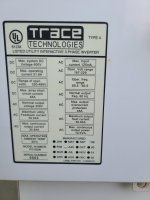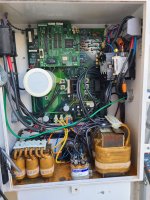Krusscher
Senior Member
- Location
- Washington State
- Occupation
- Electrician
We have a solar panel system that was installed around 2000. I guess they have been having issues with it for a while and the old electrician would just hit the estop to reset what ever fault was occurring. Well its been faulted ever since I got here and I am now getting around to looking at it. The problem right now is that the fault light is on but the lights that are supposed to flash the code are not doing that. I know they may be burnt out but I checked them with my multimeter and I can't see the voltage changing at all like its turning on and off. As you can see in the pictures it looks like it may have had issues with moisture which may have caused something to fail.
This is such an old invertor I am wondering if it would make sense to just replace it with something similar or if it is worth it to trouble shoot what is going on. If I do decide to replace can someone recommend a brand/model. In an old email my boss sent me someone from the POCO suggested installing microinverters that tie 2 modules together at a time as it would be safer then dealing with 480v of DC but I honestly think that is a bit much extra work.
This is such an old invertor I am wondering if it would make sense to just replace it with something similar or if it is worth it to trouble shoot what is going on. If I do decide to replace can someone recommend a brand/model. In an old email my boss sent me someone from the POCO suggested installing microinverters that tie 2 modules together at a time as it would be safer then dealing with 480v of DC but I honestly think that is a bit much extra work.



